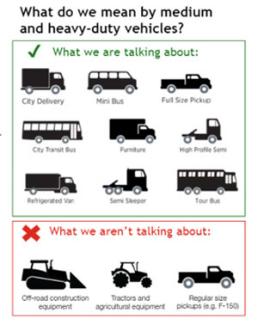Advanced Clean Cars II & Advanced Clean Trucks
In response to the threat of climate change, Rhode Island enacted the Act on Climate, which set enforceable greenhouse gas emissions reduction mandates, leading the state to achieve net-zero emissions by 2050.
The Federal Clean Air Act (CAA) grants the U.S. Environmental Protection Agency (EPA) original jurisdiction for establishing emissions standards for new motor vehicles. However, under CAA Section 177 (42 USC § 7507), states that choose to adopt vehicle emission standards that are more stringent than the federal standards for new vehicles may adopt standards that are identical to any standards adopted by the State of California. Rhode Island has previously adopted California's emissions standards for cars and passenger trucks through model year 2025. This rule furthers opt-in to California's more stringent standards through model year 2035.
Primary Resources
Quick Fact

The transportation sector is responsible for more than 38% of Rhode Islands' greenhouse gas emissions, making transportation the largest source of emissions in the state.
Public Listening Session
DEM held a virtual public listening session to announce and review the release of the "Rhode Island's Low-Emission and Zero-Emission Vehicle Programs" regulation. The regulation includes key rules to significantly reduce climate pollution from transportation: Advanced Clean Cars (ACCII) and the Advanced Clean Truck (ACT). The purpose of the listening session was to present an overview of the rule and provide an opportunity for stakeholder feedback. View slides from the listening session here.
Frequently Asked Questions
Advanced Clean Cars II (ACCII) will address zero-emission vehicle (ZEV) sales for model years 2027-2035. ACCII requires vehicle manufacturers to deliver for sale all new cars and passenger trucks with an ultimate plan that requires zero-emissions by 2035.

Advanced Clean Trucks (ACT) has an overall goal to develop a self-sustaining zero-emission truck market by requiring vehicle manufacturers to sell zero-emission medium-heavy duty vehicles (MHDVs) as an increasing percentage of their annual sales through 2035, ranging from 40-75% of sales depending on vehicle class. ACT provides vehicle manufacturers with flexibility—through credits, trading, and other features—to comply with the sales requirements as various segments of the medium- and heavy-duty ZEVs market grow at different speeds.
If ACCII and ACT regulations are not adopted, Rhode Island will revert back to the less stringent federal standards, and the state will be unable to meet the goals set in the 2021 Act on Climate.
The ACCII and ACT regulations will rapidly scale down emissions from light-duty passenger cars, pickup trucks, and SUVs along with MHDVs. Reducing these emissions is an important part of Rhode
Islands’ programs to meet and maintain the health-based National Ambient Air Quality Standards (NAAQS), reduce the risk from exposure to toxic diesel particulate matter, and reduce the
greenhouse gas (GHG) emissions that contribute to climate change. The adoption of California’s emissions standards is an imperative piece of the puzzle to Rhode Island’s response and action on climate change.
Yes. Rhode Island is only requiring that all NEW cars sold in 2035 and beyond are zero-emission vehicles. Gasoline cars can still be driven in Rhode Island, registered with the Rhode Island Department of Motor Vehicles, and sold as a used car to a new owner.
Implementing the ACCII and ACT rules will help reduce harmful pollution and greenhouse gases while mitigating adverse health impacts. These adverse impacts disproportionately affect underserved communities, communities of color, and low-income communities that are more likely to be located closest to roadways that have been most often impacted by poor air quality. Pollution from gas and diesel vehicles can worsen asthma and other cardio-respiratory illnesses, especially in children and older adults, trigger heart attacks and strokes, and lead to other negative health impacts, including premature death.
Commercial trucks comprise a small portion of vehicles on Rhode Island's roads, but they contribute an outsized percentage of carbon emissions, nitrous oxide, and particulate matter, especially along the I-95 corridor. ACT rules would reduce these forms of pollution and contribute to the improved health of our communities. They would also reduce noise pollution and help keep our rivers, parks, and beaches pristine- thus driving Rhode Island's vital tourism economy.
ACCII and ACT will result in a substantial reduction in air pollution and GHG emissions in Rhode Island. ACCII alone, will provide total cost savings of $60.7 million dollars from avoided premature deaths, avoided hospitalizations for cardiovascular and respiratory illnesses, and avoided emergency room visits due to a reduction in criteria pollution emissions reductions for the year 2040.
These regulations better position Rhode Island to benefit from the global market transition to ZEVs, zero-emission vans, buses, and trucks. By helping ensure increased availability of ZEVs for personal and business uses across the state.
By adopting these regulations, Rhode Island will fall in line with its surrounding states. Massachusetts adopted ACT in 2021 and ACCII in late-2022. Connecticut has committed to adopt ACT through a Memorandum of Understanding.
ACCII and ACT rules impose requirements on vehicle manufacturers to produce and sell vehicles in our state that may have higher upfront costs. While there are no direct costs to individuals as a result of these rules, vehicle manufacturers may choose to pass down costs to consumers. Overall direct cost savings to consumers from the use of the vehicles will be significant because of the fuel costs, maintenance, and longevity improvements. The rules require useful life and warranty provisions which will result in more durable components, resulting in less vehicle downtime, savings on operation costs, and limiting or even eliminating out-of-pocket costs for vehicle repairs during the vehicle warranty period.
For the consumer, ZEV buyers are likely to realize as much as $7,900 in maintenance and operational savings over the first 10 years of ownership. Additionally, Rhode Island imports gas and diesel fuels, so in theory with the adoption of more electric vehicles, the need for imported fuel would decrease.
The market for ZEVs, zero-emission, vans, buses, and trucks is growing quickly as the technology matures and costs decline. ACCII and ACT wouldn't go into effect until 2027 at the earliest, when the costs of these vehicles are expected to be more affordable to own and operate than their gas or diesel counterparts.
Federal funding for corridor charging will also be available under the Infrastructure Investment and Jobs Act. The ACT regulation provides market certainty that will help unlock additional charging infrastructure investments from utilities and charging station developers, including at public charging locations along interstate highway routes. In the near term, it is anticipated that the majority of charging infrastructure deployed to support electric trucks will be located at fleet depot locations. More and more utilities across the country are administering fleet advisory services and make-ready programs to help accelerate the buildout of charging infrastructure needed to support widespread truck electrification.
Over the next decade, ZEVs are expected to add only a small amount of electricity demand to Rhode Island's grid. Our utilities are planning for the transition to electric vehicle charging. Right now, the electrical grid can handle the current electric vehicle charging demand and can continue to support it for at least the next five years. As we look to future years, the utilities are incorporating planning and building to ensure enough capacity is available to deliver energy to Rhode Island for all of our uses, including charging a growing fleet of electric vehicles. In addition, Rhode Island is committed to sourcing 100% of our energy from renewable sources by 2033, and these facilities, along with the greater power system in New England, are expected to generate the electricity that will need to be delivered on the grid.
State agencies, like the Public Utilities Commission and the Rhode Island Office of Energy Resources, along with policymakers are working with utilities and implementing policies to encourage grid-friendly load growth. For example, management strategies, like time-of-use rates, will shift charging to non-peak system hours to ease grid impacts and prevent potential system overloads. Furthermore, ZEVs can be used as a grid resource and as battery storage to alleviate electricity congestion, especially with proper utility investments and rate designs that give customers the information and incentives to charge and discharge vehicles when it is most efficient.
An increasing variety of ZEVs at various price points will be critical to higher market penetration rates. Manufacturers are speeding up ZEV production lines and large numbers of new ZEV models are expected to come to market in the coming years. That increase in models and diversification should help to increase ZEV market share and availability of more mainstream priced ZEVs. GM, Volvo, Cadillac to name just a few have already committed to going 100% electric no later than 2035, and other manufacturers are investing hundreds of billions of dollars to develop and manufacture zero emission vehicles, including pickup trucks and SUVs.
Recent shortages have been attributed to global supply chain constraints on microchips. According to the National Automobile Dealers’ Association, new light-duty vehicle sales for July 2022 remain down 8.9% from July 2021, when sales first started to be constrained by the microchip shortage. Should similar supply disruptions occur in the future, the regulation provides flexibilities in the use of banked credits to facilitate compliance.
Federal legislation, including the 2021 Infrastructure Investment and Jobs Act (IIJA) and the Inflation Reduction Act of 2022 (IRA), have authorized unprecedented investment of billions of dollars in tax credits, rebates, grants, and loan programs supporting the manufacturing and adoption of ZEVs and infrastructure. These investments will reduce price, grow the market, and encourage significant demand for ZEVs. For example for electric trucks, the Qualified Commercial Tax Credit of up to $40,000 per vehicle to replace gas or diesel vehicles with a ZEV, and for electric cars, the Clean Vehicle Credit which if all criteria is met up to $7,500 in tax credit is available for new electric vehicles purchased. The Rhode Island Office of Energy Resources (OER) has a rebate program for new and used electric vehicles and electric bikes. With this program, up to $2,500 for qualified new battery and fuel cell electric vehicles is available.
As of April 2023, California, Massachusetts, New York, Oregon, Vermont, Virginia, and Washington have adopted the Advanced Clean Cars II regulations. Several other states are either considering or actively pursuing adoption of and Advanced Clean Car II regulations.
As of April 2023, California, Colorado, Massachusetts, New Jersey, New York, Oregon, Vermont, and Washington have adopted the Advanced Clean Trucks regulations. Several other states are either considering or actively pursuing adoption of and Advanced Clean Truck regulations.
In December 2022, Vermont was the first state outside of California to adopt both Advanced Clean Cars II and Advanced Clean Trucks in one rule-making package. The plan for Rhode Island is to also adopt both Advanced Clean Cars II and Advanced Clean Trucks in one rulemaking package.
Section 177 of the Clean Air Act requires at least two model years of lead time when a state adopts California’s emission standards. To adopt California standards for model year 2027, a state must adopt those standards two years before January 2, 2026; in other words, before January 2, 2024 (i.e., by the end of 2023).
For more information, contact Chelsea Priest at (401) 537-4390
